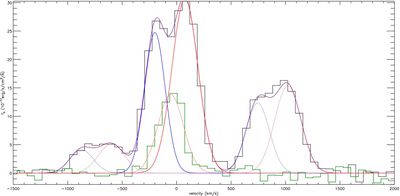We firstly report one unique object SDSS J0832+0643 with particular features of narrow balmer emission lines: double-peaked narrow H$\alpha$ but single-peaked narrow H$\beta$. The particular features can not be expected by currently proposed kinematic models for double-peaked narrow emission lines, because the proposed kinematic models lead to similar line profiles of narrow balmer emission lines. However, due to radiative transfer effects, the non-kinematic model can be naturally applied to well explain the particular features of narrow balmer emission lines: larger optical depth in H$\alpha$ than 10 leads to observed double-peaked narrow H$\alpha$, but smaller optical depth in H$\beta$ around 2 leads to observed single-peaked narrow H$\beta$. Therefore, SDSS J0832+0643 can be used as the first confirmed strong evidence for the non-kinematic origin of double-peaked narrow emission lines.

Fig.1 Properties of narrow balmer emission lines in the velocity space. Solid line in black shows the line spectrum (stellar contributions having been subtracted) around H$\alpha$ (velocities calculated relative to center wavelength of 6564.61\AA). Solid line in purple shows the best fitted result by six narrow gaussian functions for the double-peaked narrow H$\alpha$ and the double-peaked [N~{\sc ii}] doublet. Solid lines in blue and in red show the blue component and the red component of the double-peaked narrow H$\alpha$ respectively.Dotted lines in blue and in red show the blue components and the red components of the double-peaked [N~{\sc ii}] doublet. Solid line in dark green shows the observed single-peaked narrow H$\beta$ in the velocity space (velocities calculated relative to center wavelength of 4862.68\AA), and thick solid line in pink represents the best fitted result for the narrow H$\beta$ by one gaussian function.
The research work by XueGuang Zhang has been accepted and to be published in MNRAS Letter (http://mnrasl.oxfordjournals.org/content/449/1/L31.full)
